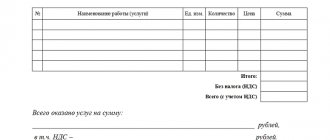Primary documents are approved by the manager and must contain all the mandatory details specified in Art. 9 of Federal Law N 402-FZ “On Accounting”.
An organization can approve in its Accounting Policy unified forms of documents previously approved by the State Statistics Committee of the Russian Federation (Resolution No. 7 of January 21, 2003). 1C uses exactly these forms.
In this article you will learn about the main types of primary documents drawn up when accounting for fixed assets and the possibility of generating printed forms in 1C.
- upon receipt of equipment requiring installation;
- when accepting fixed assets for accounting and commissioning;
- for other operations related to the use of OS objects;
- upon disposal of the OS.
Primary documents - grounds for accounting for introduced fixed assets
No property asset can appear in an enterprise “out of nowhere”: its introduction is necessarily accompanied by a number of documentary evidence. Based on the primary documentation corresponding to a specific group of production assets, each object or their group is registered on the balance sheet. Depending on whether they belong to a group of objects, the introduction of an asset may be accompanied by the following “primary”:
- acceptance certificate - for the acceptance of various objects, a certain form is provided (OS-1a - provided for structures and buildings; OS-1 - for other single objects; OS-1b - for groups of fixed assets, excluding structures and buildings);
- invoice (act) for acceptance of equipment - for equipment that does not require preliminary installation (form OS-14);
- act (invoice) of acceptance and transfer of equipment for the purpose of carrying out installation work - form OS-15.
For each new object from the fixed assets put into operation, it is necessary to create a special inventory card according to the established model:
- for a single OS object - according to the OS-6 form;
- for several grouped objects - according to the OS-6a form.
In it, the asset is assigned a unique inventory number , constant for the entire life of the asset (usually this is a serial number in a certain series).
These cards will subsequently reflect the entire “life” of the main asset in the enterprise:
- admission;
- depreciation;
- revaluation;
- modernization;
- conservation-depreservation;
- recovery;
- disposal (write-off).
The results are compiled into a single inventory book , where the final accounting of fixed assets is carried out, which must be drawn up in the OS-6b form.
statement of the dynamics of fixed assets is compiled using inventory cards .
Other operations for asset accounting
Invoice for internal movement of fixed assets according to OS-2 form
An invoice for the internal movement of fixed assets is used to document a change in the location of fixed assets within the organization, as well as when changing the materially responsible person.
It is drawn up by the financially responsible person transferring the fixed asset object in three copies:
- the first copy is transferred to the accounting department;
- the second is transferred to the financially responsible person, the recipient of the OS object;
- the third copy remains with the financially responsible person, the deliverer of the OS object.
Signed by financially responsible persons.
In 1C, the printed form Invoice for internal movement in the OS-2 form is generated from the document Transfer of OS . PDF
Certificate of acceptance and delivery of repaired, reconstructed, modernized fixed assets in the OS-3 form
The act of acceptance and delivery of repaired, reconstructed, modernized OS objects is used to formalize the acceptance and delivery of objects undergoing repair, modernization, and reconstruction.
It is issued depending on the method of repair, reconstruction, or modernization of the OS:
- in one copy, if the work was carried out using an economic method;
- in duplicate if the work was performed by contract.
Signed by the acceptance committee (the person authorized to accept OS objects) and the representative (contractor, department) carrying out the repair, modernization or reconstruction of OS objects.
The act of acceptance and delivery of repaired, reconstructed, modernized OS is approved by the heads of the recipient organization or an authorized person.
In 1C, the printed form Certificate of Acceptance and Delivery of Repaired, Reconstructed, Modernized OS Objects (form OS-3) is not implemented.
Primary cost of OS
These accounting documents must include the primary cost of fixed production assets; it consists of the costs that the enterprise actually incurred for:
- acquisition;
- delivery;
- installation;
- construction;
- acquisition of raw materials for creation;
- payment of state duty to obtain a license, etc.
IMPORTANT! The primary cost of received fixed assets does not include the amount of VAT and other fees subject to reimbursement.
Internal movement invoice
Form No. OS-$2$ is used to document the movement of objects within an organization from one structural unit to another. Issued by the transferring party in triplicate, signed by the responsible persons of the recipient and delivery departments. One copy is transferred to the accounting department, the second remains with the person responsible for the safety of the fixed asset, and the third remains with the recipient. Data on the movement are entered into inventory cards, which are placed in a file cabinet at their new location.
Accounting depending on the methods of receipt of fixed assets
Accounting for each fixed asset occurs differently; the method depends on the official source from where the fixed asset came to the enterprise. Different paths not only lead to different initial costs, but also different accounting nuances.
- Purchasing from a supplier. It is necessary to take into account all costs, including transport and installation, excluding VAT. According to accounting, this will be done in this way:
- the cost of the acquired asset excluding VAT (debit 08, credit 60);
- additional costs for delivery, installation, setup, etc. (debit 08, credit 60 or 76);
- allocation of VAT (debit 19, credit 60 or 76);
- putting the main asset into operation (debit 01, credit 08).
- Acceptance under a gift agreement. It is necessary to take into account the market price of the object, current at the time of donation (the amount must be documented).
ATTENTION! Entrepreneurs and organizations cannot make “gifts” to each other in amounts exceeding 5 minimum wages.Accounting entries:
- D08 K98/2 - the main asset was received free of charge and accepted for accounting;
D01 K08 - this material asset is put into operation;
- D98/2 K91 - writing off depreciation from account 98 to “other income”.
- Contributing your share to the authorized capital. The cost of the OS is agreed upon by the founders and regulated in the constituent documents.
NOTE! If funds are deposited for a significant amount exceeding 200 times the minimum wage, then it must be additionally assessed by an independent specialist.Accounting data:
- the property asset is introduced as a contribution to the authorized capital (debit 08, credit 75);
the main asset is put into operation (debit 01, credit 08).
- Creating an OS in-house (economic method, construction, etc.) - all costs for raw materials, the work itself (if necessary, then under contracts), transportation costs, installation, etc. are subject to accounting. Accounting:
- wages for contractors (debit 08, credit 60 or 76);
- cost of raw materials (debit 08, credit 10);
- all other costs incurred in creating the operating system (debit 08, credit 60 or 23, 25, 26, 76);
- allocation of VAT for all types of expenses (debit 19, credit 60 or 23, 25, 26, 76);
- putting a new asset into operation (debit 01, credit 08).
- Receipt under contracts where the remuneration provides for obligations other than monetary – the cost is determined in the same way as when transferring an object as a gift (based on the current market price for similar goods or services). Accounting entry:
- acceptance of funds for accounting (debit 01, credit 08);
- the asset is accounted for and put into operation (debit 01, credit 08).
On the basis of what documents is the receipt of fixed assets regulated?
Regulatory documents that are used as the basis for reflecting fixed assets in accounting and tax accounting at an enterprise include:
- Law “On Accounting” No. 402 FZ - this act defines the principles of accounting and basic concepts.
- Tax Code of the Russian Federation - this act establishes the general concepts of OS and the procedure for accounting for such objects in tax accounting.
- Regulations on accounting and accounting in Russia No. 34 - this act defines the concept of OS, and also provides a classification of these objects.
- PBU 61 is a leading regulatory act that defines not only what fixed assets are, but also establishes the rules for their assessment, accounting, execution using documents, etc.
- Guidelines for maintaining fixed assets accounting No. 91 - this act establishes the main methods for recording fixed assets, and also discusses the features of individual operations for accounting for fixed assets.
- Chart of accounts and instructions for its use No. 94n - defines the accounts on which fixed assets are recorded, and also establishes standard correspondence of these accounts with other accounting accounts.
Attention! When reflecting the receipt of fixed assets, other regulations can be used, for example, PBU 9/99 and PBU 10/99 regarding the occurrence of income and expenses that arise when purchasing fixed assets, as well as guidelines for conducting an inventory.
Unaccounted for fixed assets
Periodically, all enterprises carry out an inventory - an additional, intermediate accounting of all property assets. Sometimes the result of an inventory may be the discovery of one or more fixed assets that were not previously registered.
Such funds are subject to mandatory capitalization.
To do this, you need to find out their market value, which will be valid at the time of discovery (this moment will determine the date of entry on the balance sheet). Accounting should be made on the account “Fixed Assets” (debit 01, credit 91).
Transfer and Acceptance Certificate
Acts on acceptance and transfer of fixed assets (forms No. OS-$1$, No. OS-$1$a, No. OS-$1$b) are used to include in fixed assets a number of objects that are received:
- purchasing for a fee from third parties;
- through construction (economic or contract method);
- free receipt;
- contribution as part of the authorized capital;
- receiving into operational management;
- renting, leasing with subsequent purchase;
- receipt by deed of donation;
- from transfer to joint activities, trust management;
- transfer in exchange for other property (without contradictions to current legislation).
The document is used to record the commissioning (except for cases where the commissioning of objects must be introduced in a special order, for example, the acquisition of real estate or transport, documents confirming state registration are required). Until the state registration certificate is submitted, such funds are not subject to acceptance for accounting and remain as part of unfinished capital investments.
Too lazy to read?
Ask a question to the experts and get an answer within 15 minutes!
Ask a Question
Also, acts in this form are drawn up upon disposal (sale, exchange, gratuitous transfer).
Note 2
The act must be approved by the head of the recipient and the delivery company. Compiled in at least two copies. It is accompanied by technical documentation for this object.
The document contains data about the fixed asset object: name, inventory number, initial cost, date of commissioning, manufacturing, delivery to enterprises, useful life, method, depreciation rates. Individual characteristics are indicated: the content of precious materials, qualitative and quantitative indicators, related extensions, fixtures, and accessories. You need to indicate two or three of the most important indicators; duplication of information is best avoided. In case of group accounting, the characteristics are given as a whole for the group of objects recorded in the inventory card.
The column “State registration of rights to real estate” is filled in when registering rights to real estate and transactions with it. When purchasing used objects, forms No. OS-$1$, OS-$1$a provide a section for indicating information about the condition of the object at the time of transfer. It is filled out according to the data of the transmitting party and is for informational purposes only.
Note 3
If an item of fixed assets is owned by several organizations, its share in the right of common ownership is recorded. On the first page, information about the participants in shared ownership is entered (indicating their share), and if the cost of acquiring the fixed asset was expressed in foreign currency, information about the currency, its amount at the exchange rate of the Central Bank of the Russian Federation as of the date, in accordance with the requirements of the law.
When accepting inventory, tools, equipment for accounting, if the objects are of the same type, have the same cost, and were received in the same calendar month, an act is drawn up in form No. OS-$1$b.
After registration, the acts and all attachments to them are transferred to the accounting department of the enterprise, where an inventory card is opened for the object.
Results
The primary forms of forms for accounting for fixed assets were developed and approved by Decree of the State Statistics Committee of January 21, 2003 No. 7. However, they are samples that are only recommended for use.
Therefore, the company, along with unified forms, can use document forms developed independently and including all mandatory details. You can find more complete information on the topic in ConsultantPlus. Free trial access to the system for 2 days.





